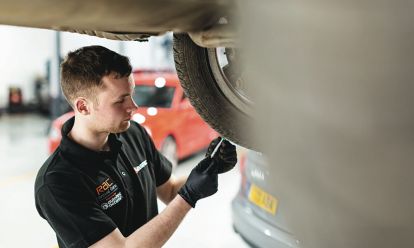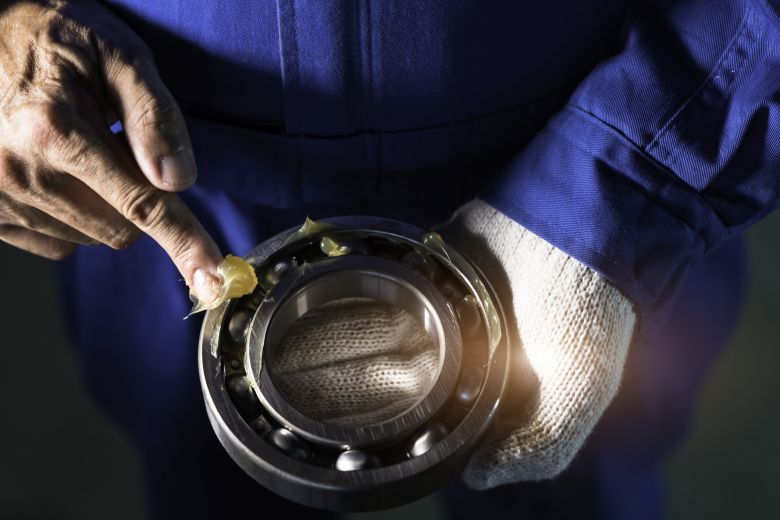A common issue for most car owners relates to the car wheel bearings. But what are they? Why are they important? And can you replace them yourself?
This guide looks at everything you need to know.
What is a wheel bearing?
A car wheel bearing is a crucial component of a vehicle's wheel assembly that enables smooth and efficient rotation of the wheel while driving.
It is a set of steel balls or rollers enclosed in a metal ring called a bearing race.
The bearing is typically mounted within a hub assembly or wheel hub, which connects the wheel to the vehicle's suspension system.
The wheel bearing serves two main functions:
- Load-bearing: It supports the weight of the vehicle and the forces exerted on the wheel while driving, such as acceleration, braking, and cornering forces. The bearing ensures that the wheel can rotate freely and withstand these loads without excessive friction or wear.
- Facilitating rotation: The bearing allows the wheel to rotate smoothly and consistently with minimal resistance. It reduces the friction between the moving parts, enabling the wheel to spin freely and without generating excessive heat.
What are the common issues with wheel bearings?
Over time, wheel bearings can wear out due to constant use, exposure to road conditions, and lack of maintenance.
Common signs of a failing wheel bearing include unusual noises such as grinding or humming coming from the wheel, vibration, uneven tyre wear, and excessive play or looseness in the wheel.
If a wheel bearing is damaged or worn, it should be replaced promptly to ensure safe operation of the vehicle and prevent further damage to other components.
Keeping on top of regular car maintenance and getting your car serviced can help avoid this issue affecting your vehicle.
Where is the car wheel bearing located?
The car wheel bearings are located within the wheel hub assembly. This is the part that connects the wheel to the vehicle's suspension system.
In most vehicles, the wheel bearing is a sealed unit that is pressed into the hub assembly. It is positioned between the inner and outer bearing races, which are the metal rings that contain the steel balls or rollers.
The hub assembly, with the wheel bearing inside, is then mounted onto the spindle or axle shaft of the vehicle.
Depending on the vehicle’s design, there may be one or two wheel bearings per wheel. In a front-wheel-drive vehicle, each front wheel usually has a wheel bearing assembly, while rear-wheel-drive vehicles may have wheel bearings in the front and rear wheels.
It’s worth noting that the specific location and design of bearings may vary slightly between different vehicle models and manufacturers. It is recommended to consult the vehicle’s manual or visit a trusted local garage for an accurate assessment and information regarding your specific car’s wheel bearing location – and what is needed to fix it.
Why is my car wheel bearing making a noise?
If you can hear a strange noise coming from your wheels – it could be an issue with your wheel bearings. It could also indicate a serious issue.
Here are some possible reasons why a wheel bearing may produce noise:
Wear and tear: Over time, bearings can wear out due to constant use and exposure to various road conditions. When they become worn, the metal balls or rollers inside may lose their smoothness, causing friction and generating noise.
Lack of lubrication: Adequate lubrication is crucial for the smooth operation of a wheel bearing. If the bearing is not properly lubricated or the lubricant has deteriorated over time, it can result in increased friction and noise.
Contamination: Dirt, debris, or water can enter the wheel bearing and cause contamination. This can accelerate wear and create noise as the foreign particles interfere with the smooth rotation of the bearing.
Improper installation: If a wheel bearing is not installed correctly during maintenance or repair, it can lead to premature wear and noise. Improper installation can result in misalignment or insufficient torque, causing the bearing to wear unevenly.
Excessive load or impact: Intense driving conditions, such as carrying heavy loads or encountering potholes and impacts, can put additional stress on the wheel bearing. This can lead to damage, wear, and ultimately noise.
If you suspect a faulty wheel bearing, it is essential to have it inspected and repaired by a qualified mechanic. Ignoring a worn or damaged wheel bearing can result in further damage to the wheel assembly and compromise the safety and performance of your vehicle. Alternatively, take your vehicle to your local garage to get the problem resolved.
How much does a new car wheel bearing cost?
The cost of a new car wheel bearing can vary depending on several factors, including the make and model of your vehicle, the location of the bearing, and whether you purchase an original equipment manufacturer part.
Additionally, labour costs for installation may vary depending on the mechanic you choose.
As a rough estimate, the price for a single wheel bearing can range from £150 to £250. However, this is only an approximate range, and the actual cost can be higher or lower depending on the factors mentioned above.
It's advisable to check with local automotive parts suppliers or contact a trusted local garage to get more accurate pricing information specific to your vehicle.
Keep in mind that if you're replacing a wheel bearing, it's usually recommended to replace both bearings on the same axle simultaneously, even if only one is showing signs of wear or damage.
This helps ensure balanced performance and reduces the chances of having to replace the other bearing shortly after.
- Mobile mechanic or local garage? The complete guide
- Car smells guide – causes and solutions
- MOT advisories – all you need to know
Car wheel bearing replacement cost
According to whocanfixmycar, the average cost to replace a wheel bearing is around £258. This includes labour and parts needed.
However, this can vary due to make, model, and type of wheel bearing required.
Here are the average costs for 2025:
| Manufacturer | Average replacement cost |
|---|---|
| Audi | £272 |
| BMW | £262 |
| Citroen | £295 |
| Ford | £235 |
| MINI | £206 |
| Nissan | £288 |
| Peugoet | £284 |
| Renault | £221 |
| Vauxhall | £200 |
| Volvo | £320 |
| Volkswagen | £282 |
How to replace a car wheel bearing?
Replacing a car wheel bearing typically involves several steps and requires some mechanical knowledge and tools. Here's a general overview of the process:
1. Preparation:
- Ensure you have a replacement wheel bearing suitable for your vehicle.
- Gather the necessary tools, which may include a jack, jack stands, lug wrench, socket set, torque wrench, pry bar, bearing press (or suitable alternative), and bearing grease.
- Park the vehicle on a flat surface, engage the parking brake, and chock the wheels for added safety.
2. Raise the vehicle:
- Use a jack to lift the corner of the vehicle where you'll be replacing the wheel bearing.
- Secure the vehicle with jack stands to prevent it from falling while you work.
3. Remove the wheel and brake assembly:
- Use a lug wrench to loosen the lug nuts on the wheel.
- Lift the wheel off the vehicle and set it aside.
- If necessary, disassemble the brake assembly by following the vehicle's repair manual instructions. This step may vary depending on your vehicle.
4. Remove the old wheel bearing:
- Locate the wheel bearing assembly, which is typically housed within the wheel hub.
- Remove any retaining hardware, such as bolts or clips, that secure the wheel bearing in place.
- Use a pry bar or suitable tool to carefully remove the wheel bearing assembly from the hub. In some cases, a bearing press or similar tool may be required.
5. Install the new wheel bearing:
- Apply a suitable amount of bearing grease to the inner race of the new wheel bearing.
- Align the new bearing with the hub and press it into place. Ensure it is properly seated and secured according to the manufacturer's instructions.
6. Reassemble the brake assembly and wheel:
- If you disassembled the brake assembly, follow the vehicle's repair manual instructions to reinstall the brake rotor, calliper, and other components.
- Place the wheel back onto the vehicle and tighten the lug nuts securely.
7. Lower the vehicle:
- Carefully remove the jack stands and lower the vehicle to the ground.
8. Torque the lug nuts:
- Use a torque wrench to tighten the lug nuts to the manufacturer's specifications. This is important to ensure proper wheel attachment and prevent issues while driving.
It's crucial to note that these are general guidelines, and the specific steps and procedures can vary depending on your vehicle's make and model.
It is highly recommended to consult your vehicle's repair manual, call a mobile mechanic or seek professional assistance from a local garage.
Are you experiencing a car fault, warning, or mechanical problem on your road trip? Find a local mechanic with the RAC.
Service, repair or MOT?
You can trust the RAC with our local approved garages and NEW mobile mechanics.












